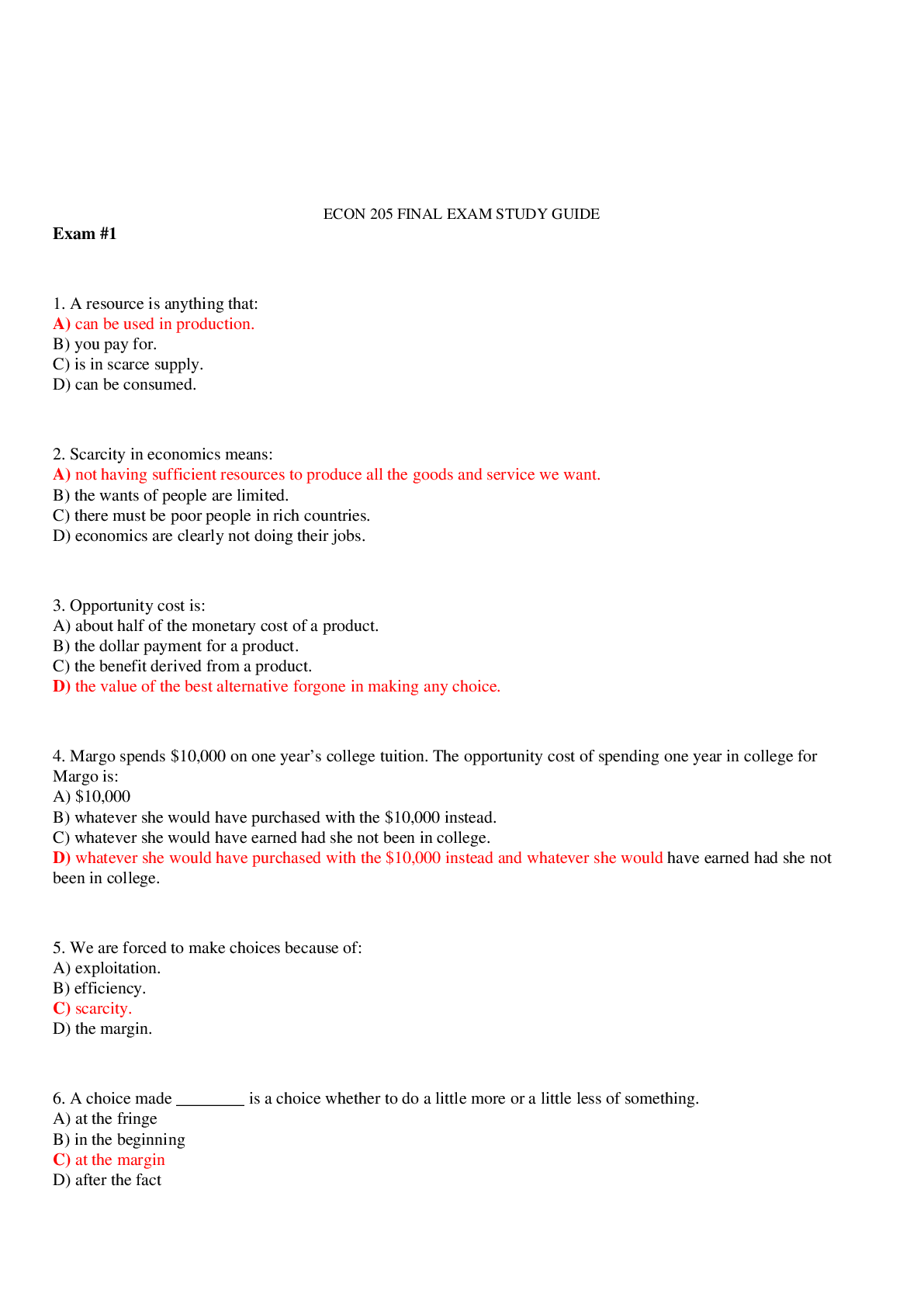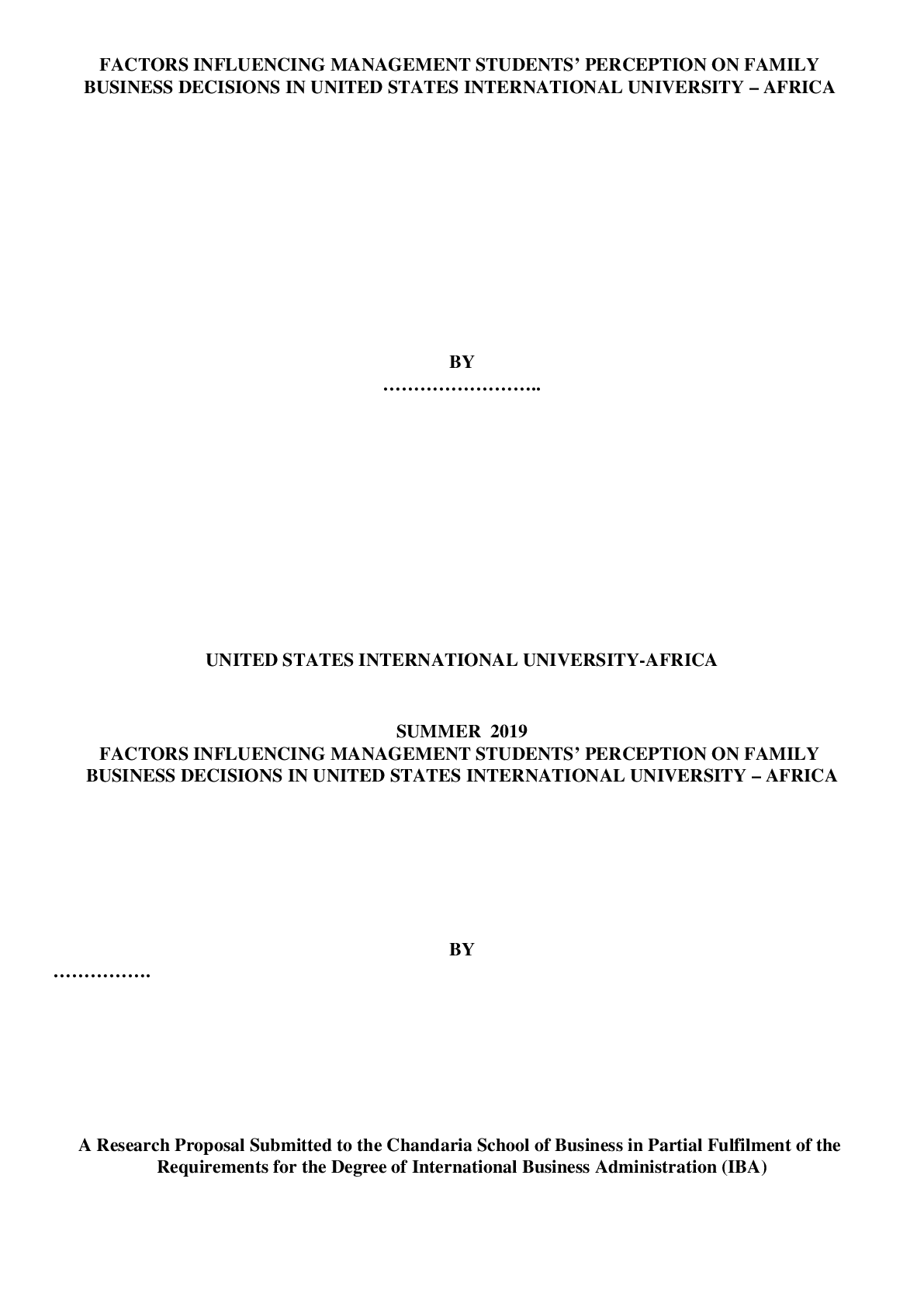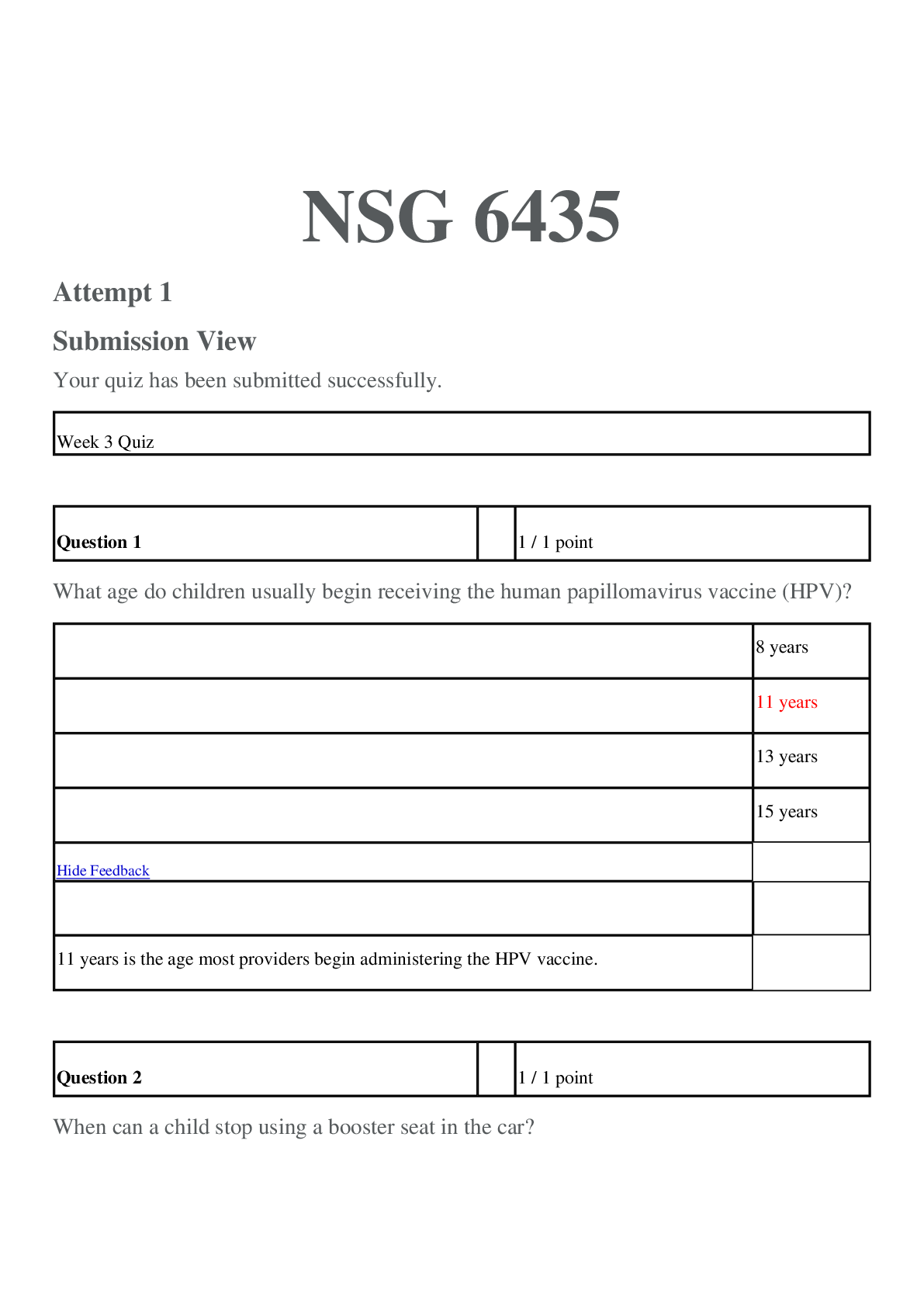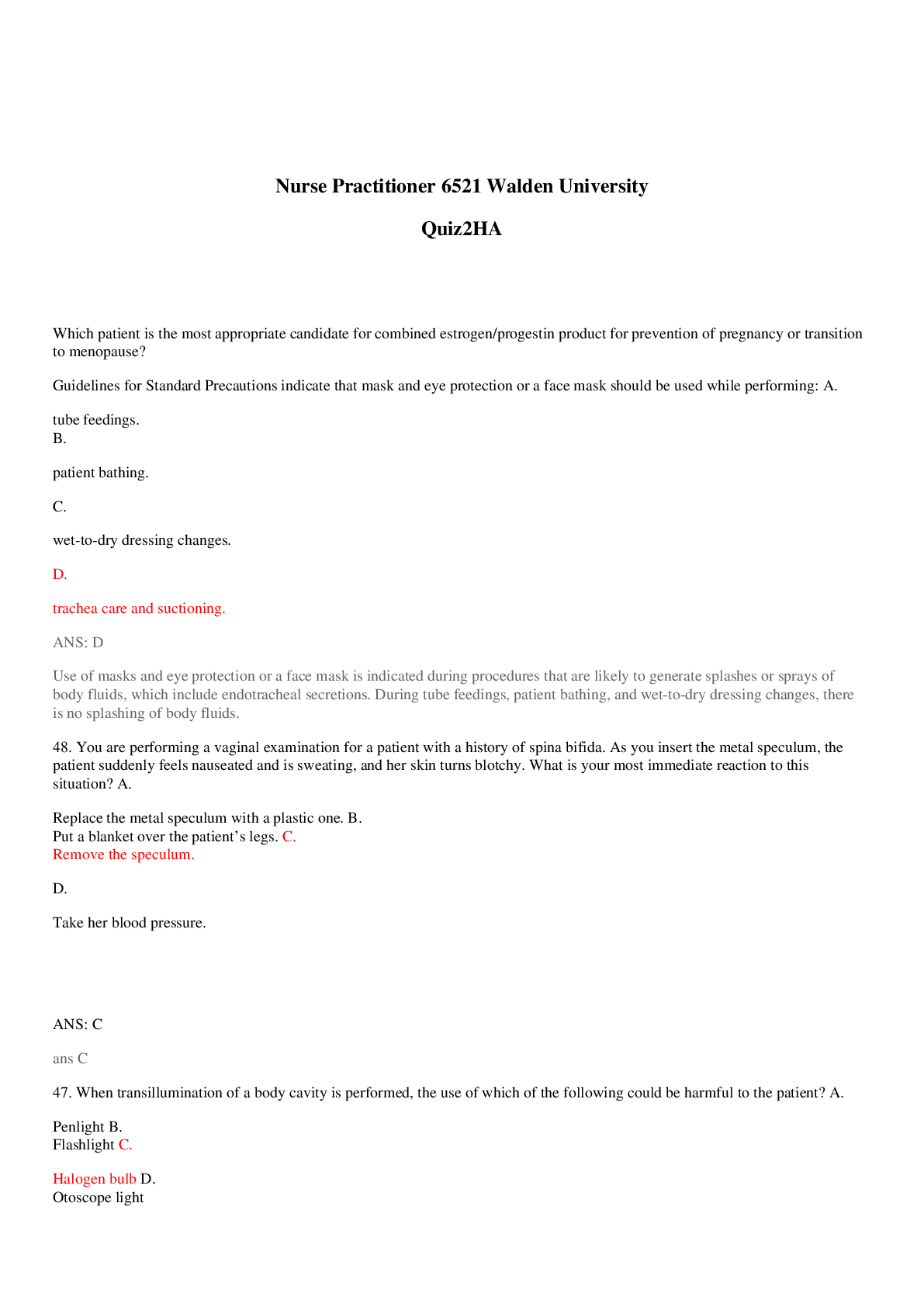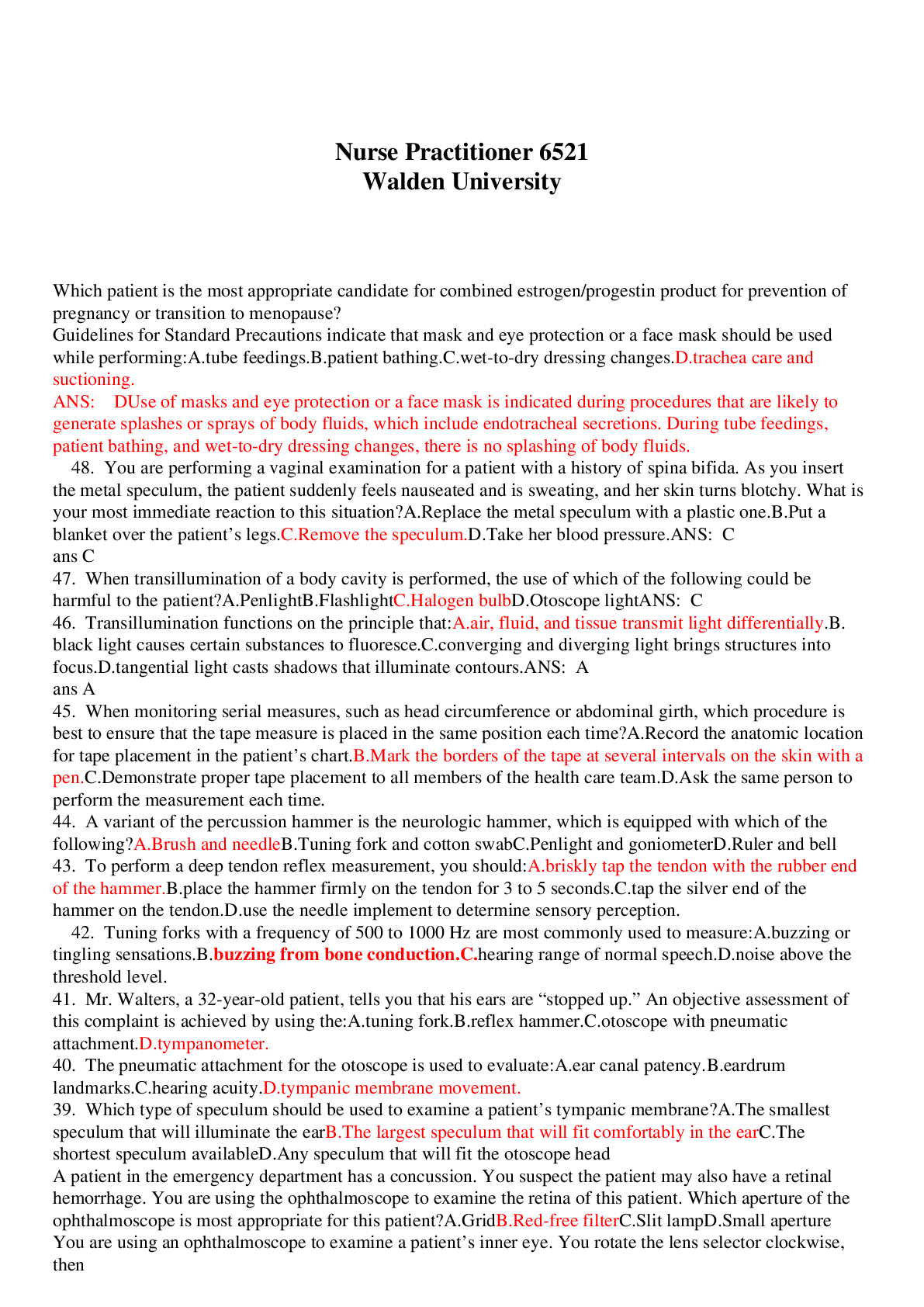Male Genitourinary System
Document Content and Description Below
Chapter 25: Male Genitourinary System MULTIPLE CHOICE 1. The external male genital structures include the: a. Testis. b. Scrotum. c. Epididymis. d. Vas deferens. The external male g... enital structures include the penis and scrotum. The testis, epididymis, and vas deferens are internal structures. DIF: Cognitive Level: Remembering (Knowledge) MSC: Client Needs: General 2. An accessory glandular structure for the male genital organs is the: a. Testis. b. Scrotum. c. Prostate. d. Vas deferens. NURSINGTB.COM Glandular structures accessory to the male genital organs are the prostate, seminal vesicles, and bulbourethral glands. DIF: Cognitive Level: Remembering (Knowledge) MSC: Client Needs: General 3. Which of these statements is true regarding the penis? a. The urethral meatus is located on the ventral side of the penis. b. The prepuce is the fold of foreskin covering the shaft of the penis. c. The penis is made up of two cylindrical columns of erectile tissue. d. The corpus spongiosum expands into a cone of erectile tissue called the glans. At the distal end of the shaft, the corpus spongiosum expands into a cone of erectile tissue, the glans. The penis is made up of three cylindrical columns of erectile tissue. The skin that covers the glans of the penis is the prepuce. The urethral meatus forms at the tip of the glans. DIF: Cognitive Level: Remembering (Knowledge) MSC: Client Needs: General 4. When performing a genital examination on a 25-year-old man, the nurse notices deeply pigmented, wrinkled scrotal skin with large sebaceous follicles. On the basis of this information, the nurse would: a. Squeeze the glans to check for the presence of discharge. b. Consider this finding as normal, and proceed with the examination. c. Assess the testicles for the presence of masses or painless lumps. d. Obtain a more detailed history, focusing on any scrotal abnormalities the patient has noticed. After adolescence, the scrotal skin is deeply pNigUmReSnItNedGaTnBd.ChOasMlarge sebaceous follicles and appears corrugated. DIF: Cognitive Level: Applying (Application) MSC: Client Needs: Health Promotion and Maintenance 5. Which statement concerning the testes is true? a. The lymphatic vessels of the testes drain into the abdominal lymph nodes. b. The vas deferens is located along the inferior portion of each testis. c. The right testis is lower than the left because the right spermatic cord is longer. d. The cremaster muscle contracts in response to cold and draws the testicles closer to the body. When it is cold, the cremaster muscle contracts, which raises the scrotal sac and brings the testes closer to the body to absorb heat necessary for sperm viability. The lymphatic vessels of the testes drain into the inguinal lymph nodes. The vas deferens is located along the upper portion of each testis. The left testis is lower than the right because the left spermatic cord is longer. DIF: Cognitive Level: Remembering (Knowledge) MSC: Client Needs: General 6. A male patient with possible fertility problems asks the nurse where sperm is produced. The nurse knows that sperm production occurs in the: a. Testes. b. Prostate. c. Epididymis. d. Vas deferens. Sperm production occurs in the testes, not in the other structures listed. DIF: Cognitive Level: Remembering (Knowledge) MSC: Client Needs: Physiologic Integrity 7. A 62-year-old man states that his physician told him that he has an inguinal hernia. He asks the nurse to explain what a hernia is. The nurse should: a. Tell him not to worry and that most men his age develop hernias. NURSINGTB.COM b. Explain that a hernia is often the result of prenatal growth abnormalities. c. Refer him to his physician for additional consultation because the physician made the initial diagnosis. d. Explain that a hernia is a loop of bowel protruding through a weak spot in the abdominal muscles. A hernia is a loop of bowel protruding through a weak spot in the musculature. The other options are not correct responses to the patients question. DIF: Cognitive Level: Applying (Application) MSC: Client Needs: Physiologic Integrity 8. The mother of a 10-year-old boy asks the nurse to discuss the recognition of puberty. The nurse should reply by saying: a. Puberty usually begins around 15 years of age. b. The first sign of puberty is an enlargement of the testes. c. The penis size does not increase until about 16 years of age. d. The development of pubic hair precedes testicular or penis enlargement. Puberty begins sometime between age 9 for African Americans and age 10 for Caucasians and Hispanics. The first sign is an enlargement of the testes. Pubic hair appears next, and then penis size increases. DIF: Cognitive Level: Applying (Application) MSC: Client Needs: Health Promotion and Maintenance 9. During an examination of an aging man, the nurse recognizes that normal changes to expect would be: a. Enlarged scrotal sac. b. Increased pubic hair. c. Decreased penis size. d. Increased rugae over the scrotum. In the aging man, the amount of pubic hair decreases, the penis size decreases, and the rugae over the scrotal sac decreases. The scrotal sac does not enlargeN.URSINGTB.COM DIF: Cognitive Level: Understanding (Comprehension) MSC: Client Needs: Health Promotion and Maintenance 10. An older man is concerned about his sexual performance. The nurse knows that in the absence of disease, a withdrawal from sexual activity later in life may be attributable to: a. Side effects of medications. b. Decreased libido with aging. c. Decreased sperm production. d. Decreased pleasure from sexual intercourse. In the absence of disease, a withdrawal from sexual activity may be attributable to side effects of medications such as antihypertensives, antidepressants, sedatives, psychotropics, antispasmotics, tranquilizers or narcotics, and estrogens. The other options are not correct. DIF: Cognitive Level: Understanding (Comprehension) MSC: Client Needs: Health Promotion and Maintenance 11. A 59-year-old patient has been diagnosed with prostatitis and is being seen at the clinic for complaints of burning and pain during urination. He is experiencing: a. Dysuria. b. Nocturia. c. Polyuria. d. Hematuria. Dysuria (burning with urination) is common with acute cystitis, prostatitis, and urethritis. Nocturia is voiding during the night. Polyuria is voiding in excessive quantities. Hematuria is voiding with blood in the urine. DIF: Cognitive Level: Applying (Application) MSC: Client Needs: Physiologic Integrity: Physiologic Adaptation 12. A 45-year-old mother of two children is seen at the clinic for complaints of losing my urine when I sneeze. The nurse documents that she is experiencing: a. Urinary frequency. b. Enuresis. c. Stress incontinence. d. Urge incontinence. NURSINGTB.COM Stress incontinence is involuntary urine loss with physical strain, sneezing, or coughing that occurs as a result to weakness of the pelvic floor. Urinary frequency is urinating more times than usual (more than five to six times per day). Enuresis is involuntary passage of urine at night after age 5 to 6 years (bed wetting). Urge incontinence is involuntary urine loss from overactive detrusor muscle in the bladder. It contracts, causing an urgent need to void. DIF: Cognitive Level: Applying (Application) MSC: Client Needs: Physiologic Integrity: Physiologic Adaptation 13. When the nurse is conducting sexual history from a male adolescent, which statement would be most appropriate to use at the beginning of the interview? a. Do you use condoms? b. You dont masturbate, do you? c. Have you had sex in the last 6 months? d. Often adolescents your age have questions about sexual activity. The interview should begin with a permission statement, which conveys that it is normal and acceptable to think or feel a certain way. Sounding judgmental should be avoided. DIF: Cognitive Level: Analyzing (Analysis) MSC: Client Needs: Health Promotion and Maintenance 14. Which of these statements is most appropriate when the nurse is obtaining a genitourinary history from an older man? a. Do you need to get up at night to urinate? b. Do you experience nocturnal emissions, or wet dreams? c. Do you know how to perform a testicular self-examination? d. Has anyone ever touched your genitals when you did not want them to? NURSINGTB.COM The older male patient should be asked about the presence of nocturia. Awaking at night to urinate may be attributable to a diuretic medication, fluid retention from mild heart failure or varicose veins, or fluid ingestion 3 hours before bedtime, especially coffee and alcohol. The other questions are more appropriate for younger men. DIF: Cognitive Level: Analyzing (Analysis) MSC: Client Needs: Health Promotion and Maintenance 15. When the nurse is performing a genital examination on a male patient, the patient has an erection. The nurses most appropriate action or response is to: a. Ask the patient if he would like someone else to examine him. b. Continue with the examination as though nothing has happened. c. Stop the examination, leave the room while stating that the examination will resume at a later time. d. Reassure the patient that this is a normal response and continue with the examination. When the male patient has an erection, the nurse should reassure the patient that this is a normal physiologic response to touch and proceed with the rest of the examination. The other responses are not correct and may be perceived as judgmental. DIF: Cognitive Level: Applying (Application) MSC: Client Needs: Psychosocial Integrity 16. The nurse is examining the glans and knows which finding is normal for this area? a. The meatus may have a slight discharge when the glans is compressed. b. Hair is without pest inhabitants. c. The skin is wrinkled and without lesions. d. Smegma may be present under the foreskin of an uncircumcised male. The glans looks smooth and without lesions and does not have hair. The meatus should not have any discharge when the glans is compressed. Some cheesy smegma may have collected under the foreskin of an uncircumcised male. DIF: Cognitive Level: Understanding (Comprehension) MSC: Client Needs: Safe and Effective Care Environment: Management of Care 17. When performing a genitourinary assessmNenUtR, tShIeNnGuTrsBe.CnOotMices that the urethral meatus is ventrally positioned. This finding is: a. Called hypospadias. b. A result of phimosis. c. Probably due to a stricture. d. Often associated with aging. Normally, the urethral meatus is positioned just about centrally. Hypospadias is the ventral location of the urethral meatus. The position of the meatus does not change with aging. Phimosis is the inability to retract the foreskin. A stricture is a narrow opening of the meatus. DIF: Cognitive Level: Applying (Application) MSC: Client Needs: Safe and Effective Care Environment: Management of Care 18. The nurse is performing a genital examination on a male patient and notices urethral drainage. When collecting urethral discharge for microscopic examination and culture, the nurse should: a. Ask the patient to urinate into a sterile cup. b. Ask the patient to obtain a specimen of semen. c. Insert a cotton-tipped applicator into the urethra. d. Compress the glans between the examiners thumb and forefinger, and collect any discharge. If urethral discharge is noticed, then the examiner should collect a smear for microscopic examination and culture by compressing the glans anteroposteriorly between the thumb and forefinger. The other options are no correct actions. DIF: Cognitive Level: Applying (Application) MSC: Client Needs: Safe and Effective Care Environment: Management of Care 19. When assessing the scrotum of a male patient, the nurse notices the presence of multiple firm, nontender, yellow 1-cm nodules. The nurse knows that these nodules are most likely: a. From urethritis. b. Sebaceous cysts. c. Subcutaneous plaques. NURSINGTB.COM d. From an inflammation of the epididymis. Sebaceous cysts are commonly found on the scrotum. These yellowish 1-cm nodules are firm, nontender, and often multiple. The other options are not correct. DIF: Cognitive Level: Analyzing (Analysis) MSC: Client Needs: Physiologic Integrity: Physiologic Adaptation 20. When performing a scrotal assessment, the nurse notices that the scrotal contents show a red glow with transillumination. On the basis of this finding the nurse would: a. Assess the patient for the presence of a hernia. b. Suspect the presence of serous fluid in the scrotum. c. Consider this finding normal, and proceed with the examination. d. Refer the patient for evaluation of a mass in the scrotum. Normal scrotal contents do not allow light to pass through the scrotum. However, serous fluid does transilluminate and shows as a red glow. Neither a mass nor a hernia would transilluminate. DIF: Cognitive Level: Analyzing (Analysis) MSC: Client Needs: Physiologic Integrity: Physiologic Adaptation 21. When the nurse is performing a genital examination on a male patient, which action is correct? a. Auscultating for the presence of a bruit over the scrotum b. Palpating for the vertical chain of lymph nodes along the groin, inferior to the inguinal ligament c. Palpating the inguinal canal only if a bulge is present in the inguinal region during inspection d. Having the patient shift his weight onto the left (unexamined) leg when palpating for a hernia on the right side When palpating for the presence of a hernia on the right side, the male patient is asked to shift his weight onto the left (unexamined) leg. Auscultating for a bruit over the scrotum is not appropriate. When palpating for lymph nodes, the horizontal chain is palpated. The inguinal canal should be palpated whether a bulge is present or not. DIF: Cognitive Level: Applying (Application) MSC: Client Needs: Safe and Effective Care ENnUvRirSoInNmGeTnBt:.CMOaMnagement of Care 22. The nurse is aware of which statement to be true regarding the incidence of testicular cancer? a. Testicular cancer is the most common cancer in men aged 30 to 50 years. b. The early symptoms of testicular cancer are pain and induration. c. Men with a history of cryptorchidism are at the greatest risk for the development of testicular cancer. d. The cure rate for testicular cancer is low. Men with undescended testicles (cryptorchidism) are at the greatest risk for the development of testicular cancer. The overall incidence of testicular cancer is rare. Although testicular cancer has no early symptoms, when detected early and treated before metastasizing, the cure rate is almost 100%. DIF: Cognitive Level: Understanding (Comprehension) MSC: Client Needs: Health Promotion and Maintenance 23. The nurse is describing how to perform a testicular self-examination to a patient. Which statement is most appropriate? a. A good time to examine your testicles is just before you take a shower. b. If you notice an enlarged testicle or a painless lump, call your health care provider. c. The testicle is egg shaped and movable. It feels firm and has a lumpy consistency. d. Perform a testicular examination at least once a week to detect the early stages of testicular cancer. If the patient notices a firm painless lump, a hard area, or an overall enlarged testicle, then he should call his health care provider for further evaluation. The testicle normally feels rubbery with a smooth surface. A good time to examine the testicles is during the shower or bath, when ones hands are warm and soapy and the scrotum is warm. Testicular self-examination should be performed once a month. DIF: Cognitive Level: Applying (Application) MSC: Client Needs: Health Promotion and Maintenance 24. A 2-month-old uncircumcised infant has been brought to the clinic for a well-baby checkup. How would the nurse proceed with the genital examination? a. Eliciting the cremasteric reflex is recommended. b. The glans is assessed for redness or lesions. NURSINGTB.COM c. Retracting the foreskin should be avoided until the infant is 3 months old. d. Any dirt or smegma that has collected under the foreskin should be noted. If uncircumcised, then the foreskin is normally tight during the first 3 months and should not be retracted because of the risk of tearing the membrane attaching the foreskin to the shaft. The other options are not correct. DIF: Cognitive Level: Applying (Application) MSC: Client Needs: Safe and Effective Care Environment: Management of Care 25. A 2-year-old boy has been diagnosed with physiologic cryptorchidism. Considering this diagnosis, during assessment the nurse will most likely observe: a. Testes that are hard and painful to palpation. b. Atrophic scrotum and a bilateral absence of the testis. c. Absence of the testis in the scrotum, but the testis can be milked down. d. Testes that migrate into the abdomen when the child squats or sits cross-legged. Migratory testes (physiologic cryptorchidism) are common because of the strength of the cremasteric reflex and the small mass of the prepubertal testes. The affected side has a normally developed scrotum and the testis can be milked down. The other responses are not correct. DIF: Cognitive Level: Applying (Application) MSC: Client Needs: Physiologic Integrity: Physiologic Adaptation 26. The nurse knows that a common assessment finding in a boy younger than 2 years old is: a. Inflamed and tender spermatic cord. b. Presence of a hernia in the scrotum. c. Penis that looks large in relation to the scrotum. d. Presence of a hydrocele, or fluid in the scrotum. A common scrotal finding in boys younger than 2 years of age is a hydrocele, or fluid in the scrotum. The othe options are not correct. NURSINGTB.COM DIF: Cognitive Level: Applying (Application) MSC: Client Needs: Health Promotion and Maintenance 27. During an examination of an aging man, the nurse recognizes that normal changes to expect would be: a. Change in scrotal color. b. Decrease in the size of the penis. c. Enlargement of the testes and scrotum. d. Increase in the number of rugae over the scrotal sac. When assessing the genitals of an older man, the nurse may notice thinner, graying pubic hair and a decrease in the size of the penis. The size of the testes may be decreased, they may feel less firm, and the scrotal sac is pendulous with less rugae. No change in scrotal color is observed. DIF: Cognitive Level: Applying (Application) MSC: Client Needs: Health Promotion and Maintenance 28. When performing a genital assessment on a middle-aged man, the nurse notices multiple soft, moist, painless papules in the shape of cauliflower-like patches scattered across the shaft of the penis. These lesions are characteristic of: a. Carcinoma. b. Syphilitic chancres. c. Genital herpes. d. Genital warts. The lesions of genital warts are soft, pointed, moist, fleshy, painless papules that may be single or multiple in a cauliflower-like patch. They occur on the shaft of the penis, behind the corona, or around the anus, where they may grow into large grapelike clusters. DIF: Cognitive Level: Analyzing (Analysis) MSC: Client Needs: Physiologic Integrity: Physiologic Adaptation 29. A 15-year-old boy is seen in the clinic for complaints of dull pain and pulling in the scrotal area. On examination, the nurse palpates a soft, irregular mass posterior to and above the testis on the left. This mass collapses when the patient is supine and refills when he is upright. This description is consistent with: a. Epididymitis. b. Spermatocele. c. Testicular torsion. d. Varicocele. NURSINGTB.COM A varicocele consists of dilated, tortuous varicose veins in the spermatic cord caused by incompetent valves within the vein. Symptoms include dull pain or a constant pulling or dragging feeling, or the individual may be asymptomatic. When palpating the mass, the examiner will feel a soft, irregular mass posterior to and above the testis that collapses when the individual is supine and refills when the individual is upright. DIF: Cognitive Level: Analyzing (Analysis) MSC: Client Needs: Physiologic Integrity: Physiologic Adaptation 30. When performing a genitourinary assessment on a 16-year-old male adolescent, the nurse notices a swelling in the scrotum that increases with increased intra-abdominal pressure and decreases when he is lying down. The patient complains of pain when straining. The nurse knows that this description is most consistent with a(n) hernia. a. Femoral b. Incisional c. Direct inguinal d. Indirect inguinal With indirect inguinal hernias, pain occurs with straining and a soft swelling increases with increased intra- abdominal pressure, which may decrease when the patient lies down. These findings do not describe the other hernias. DIF: Cognitive Level: Analyzing (Analysis) MSC: Client Needs: Physiologic Integrity: Physiologic Adaptation 31. When the nurse is performing a testicular examination on a 25-year-old man, which finding is considered normal? a. Nontender subcutaneous plaques b. Scrotal area that is dry, scaly, and nodular c. Testes that feel oval and movable and are slightly sensitive to compression d. Single, hard, circumscribed, movaNblUeRmSaIsNsG, lTeBss.CthOaMn 1 cm under the surface of the testes Testes normally feel oval, firm and rubbery, smooth, and bilaterally equal and are freely movable and slightly tender to moderate pressure. The scrotal skin should not be dry, scaly, or nodular or contain subcutaneous plaques. Any mass would be an abnormal finding. DIF: Cognitive Level: Applying (Application) MSC: Client Needs: Safe and Effective Care Environment: Management of Care 32. The nurse is inspecting the scrotum and testes of a 43-year-old man. Which finding would require additional follow-up and evaluation? a. Skin on the scrotum is taut. b. Left testicle hangs lower than the right testicle. c. Scrotal skin has yellowish 1-cm nodules that are firm and nontender. d. Testes move closer to the body in response to cold temperatures. Scrotal swelling may cause the skin to be taut and to display pitting edema. Normal scrotal skin is rugae, and asymmetry is normal with the left scrotal half usually lower than the right. The testes may move closer to the body in response to cold temperatures. DIF: Cognitive Level: Analyzing (Analysis) MSC: Client Needs: Physiologic Integrity: Physiologic Adaptation 33. A 55-year-old man is experiencing severe pain of sudden onset in the scrotal area. It is somewhat relieved by elevation. On examination the nurse notices an enlarged, red scrotum that is very tender to palpation. Distinguishing the epididymis from the testis is difficult, and the scrotal skin is thick and edematous. This description is consistent with which of these? a. Varicocele b. Epididymitis c. Spermatocele d. Testicular torsion Epididymitis presents as severe pain of sudden onset in the scrotum that is somewhat relieved by elevation. On examination, the scrotum is enlarged, reddened, and exquisitely tender. The epididymis is enlarged and indurated and may be hard to distinguish from the testis. The overlying scrotal skin may be thick and edematous. DIF: Cognitive Level: Analyzing (Analysis) NURSINGTB.COM MSC: Client Needs: Physiologic Integrity: Physiologic Adaptation 34. The nurse is performing a genitourinary assessment on a 50-year-old obese male laborer. On examination, the nurse notices a painless round swelling close to the pubis in the area of the internal inguinal ring that is easily reduced when the individual is supine. These findings are most consistent with a(n) hernia. a. Scrotal b. Femoral c. Direct inguinal d. Indirect inguinal Direct inguinal hernias occur most often in men over the age of 40 years. It is an acquired weakness brought on by heavy lifting, obesity, chronic cough, or ascites. The direct inguinal hernia is usually a painless, round swelling close to the pubis in the area of the internal inguinal ring that is easily reduced when the individual is supine. DIF: Cognitive Level: Analyzing (Analysis) MSC: Client Needs: Physiologic Integrity: Physiologic Adaptation 35. The nurse is providing patient teaching about an erectile dysfunction drug. One of the drugs potential side effects is prolonged, painful erection of the penis without sexual stimulation, which is known as: a. Orchitis. b. Stricture. c. Phimosis. d. Priapism. Priapism is prolonged, painful erection of the penis without sexual desire. Orchitis is inflammation of the testes. Stricture is a narrowing of the opening of the urethral meatus. Phimosis is the inability to retract the foreskin. DIF: Cognitive Level: Remembering (Knowledge) MSC: Client Needs: Physiologic Integrity: Physiologic Adaptation 36. During an examination, the nurse notices that a male patient has a red, round, superficial ulcer with a yellowish serous discharge on his penis. On palpation, the nurse finds a nontender base that feels like a small button between the thumb and fingers. At this point the nurse suspects that this patient has: NURSINGTB.COM a. Genital warts. b. Herpes infection. c. Syphilitic chancre. d. Carcinoma lesion. This lesion indicates syphilitic chancre, which begins within 2 to 4 weeks of infection. DIF: Cognitive Level: Analyzing (Analysis) MSC: Client Needs: Physiologic Integrity: Physiologic Adaptation 37. During a health history, a patient tells the nurse that he has trouble in starting his urine stream. This problem is known as: a. Urgency. b. Dribbling. c. Frequency. d. Hesitancy. Hesitancy is trouble in starting the urine stream. Urgency is the feeling that one cannot wait to urinate. Dribbling is the last of the urine before or after the main act of urination. Frequency is urinating more often than usual. DIF: Cognitive Level: Understanding (Comprehension) MSC: Client Needs: Physiologic Integrity: Physiologic Adaptation 38. During a genital examination, the nurse notices that a male patient has clusters of small vesicles on the glans, surrounded by erythema. The nurse recognizes that these lesions are: a. Peyronie disease. b. Genital warts. c. Genital herpes. d. Syphilitic cancer. NURSINGTB.COM Genital herpes, or herpes simplex virus 2 (HSV-2), infections are indicated with clusters of small vesicles with surrounding erythema, which are often painful and erupt on the glans or foreskin. DIF: Cognitive Level: Applying (Application) MSC: Client Needs: Physiologic Integrity: Physiologic Adaptation 39. During a physical examination, the nurse finds that a male patients foreskin is fixed and tight and will not retract over the glans. The nurse recognizes that this condition is: a. Phimosis. b. Epispadias. c. Urethral stricture. d. Peyronie disease. With phimosis, the foreskin is nonretractable, forming a pointy tip of the penis with a tiny orifice at the end of the glans. The foreskin is advanced and so tight that it is impossible to retract over the glans. This condition may be congenital or acquired from adhesions related to infection. DIF: Cognitive Level: Applying (Application) MSC: Client Needs: Physiologic Integrity: Physiologic Adaptation MULTIPLE RESPONSE 1. A 55-year-old man is in the clinic for a yearly checkup. He is worried because his father died of prostate cancer. The nurse knows which tests should be performed at this time? Select all that apply. a. Blood test for prostate-specific antigen (PSA) b. Urinalysis c. Transrectal ultrasound d. Digital rectal examination (DRE) e. Prostate biopsy Prostate cancer is typically detected by testing the blood for PSA or by a DRE. It is recommended that both PSA and DRE be offered to men annually, beginning at age 50 years. If the PSA is elevated, then further laboratory work or a transrectal ultrasound (TRUS) and biopsy may be recommended. DIF: Cognitive Level: Applying (Application)NURSINGTB.COM MSC: Client Needs: Health Promotion and Maintenance 2. A 16-year-old boy is brought to the clinic for a problem that he refused to let his mother see. The nurse examines him, and finds that he has scrotal swelling on the left side. He had the mumps the previous week, and the nurse suspects that he has orchitis. Which of the following assessment findings support this diagnosis? Select all that apply. a. Swollen testis b. Mass that transilluminates c. Mass that does not transilluminate d. Scrotum that is nontender upon palpation e. Scrotum that is tender upon palpation f. Scrotal skin that is reddened With orchitis, the testis is swollen, with a feeling of weight, and is tender or painful. The mass does not transilluminate, and the scrotal skin is reddened. Transillumination of a mass occurs with a hydrocele, not orchitis. DIF: Cognitive Level: Applying (Application) MSC: Client Needs: Health Promotion and Maintenance NURSINGTB.COM [Show More]
Last updated: 1 year ago
Preview 1 out of 18 pages
Instant download
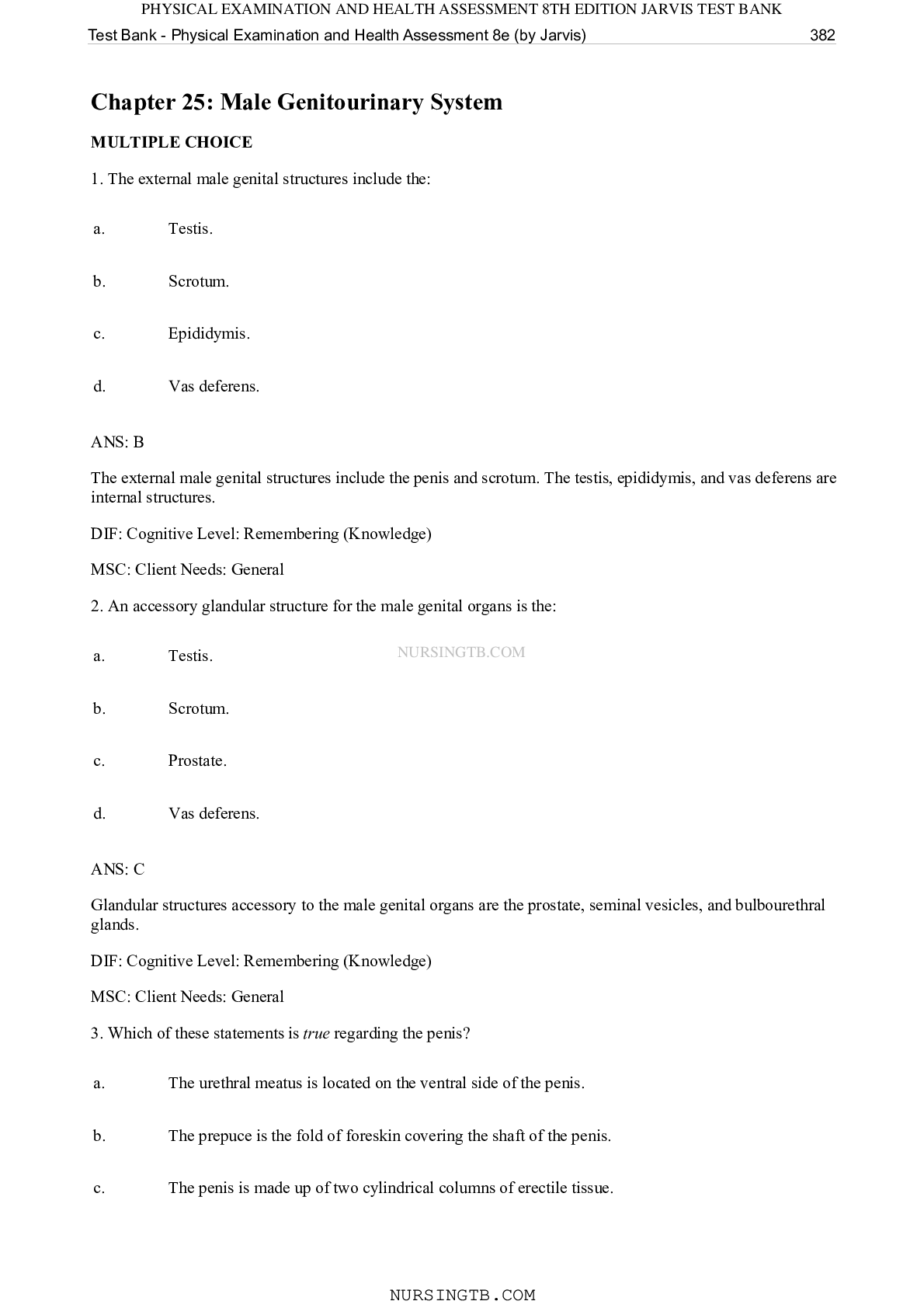
Buy this document to get the full access instantly
Instant Download Access after purchase
Add to cartInstant download
Reviews( 0 )
Document information
Connected school, study & course
About the document
Uploaded On
Dec 01, 2020
Number of pages
18
Written in
Additional information
This document has been written for:
Uploaded
Dec 01, 2020
Downloads
0
Views
141

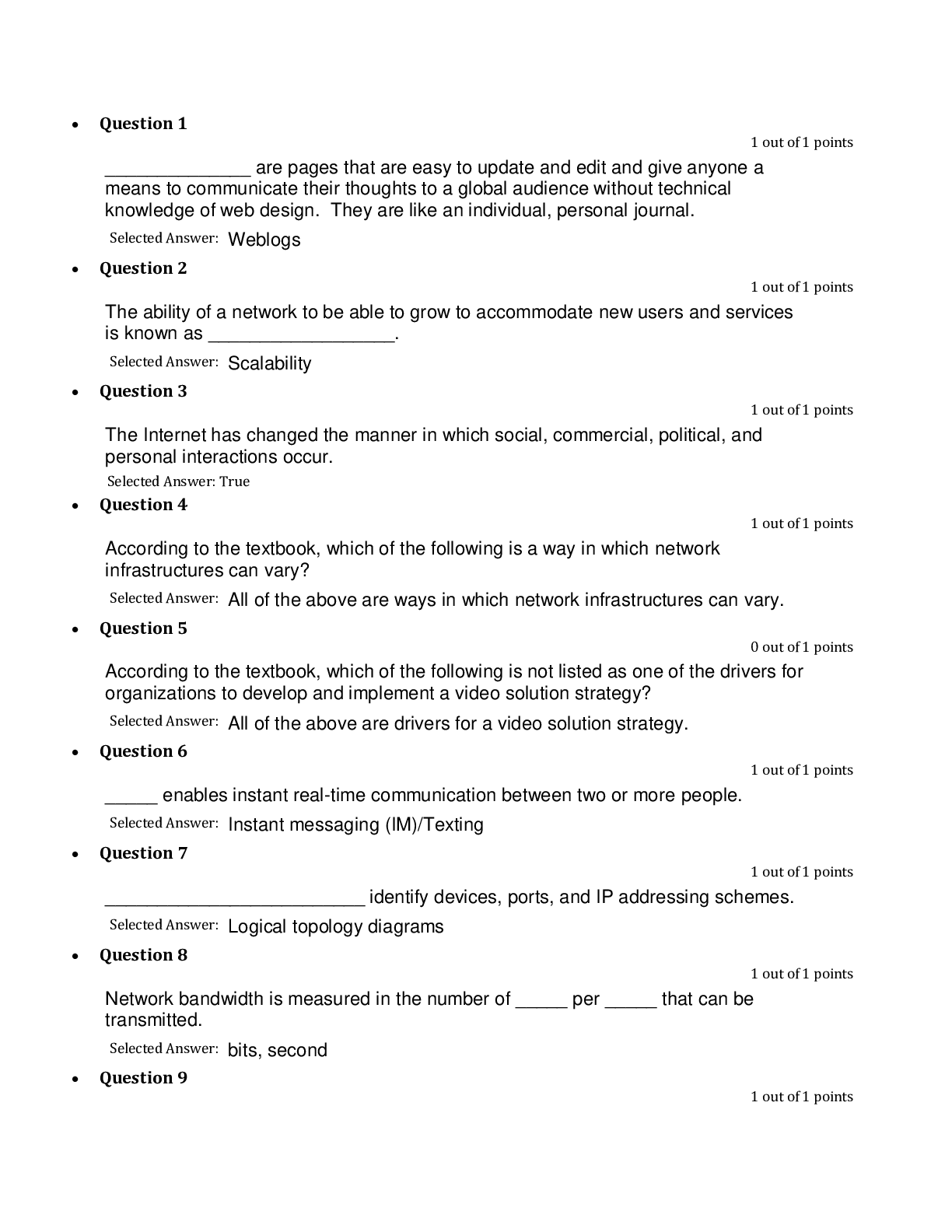


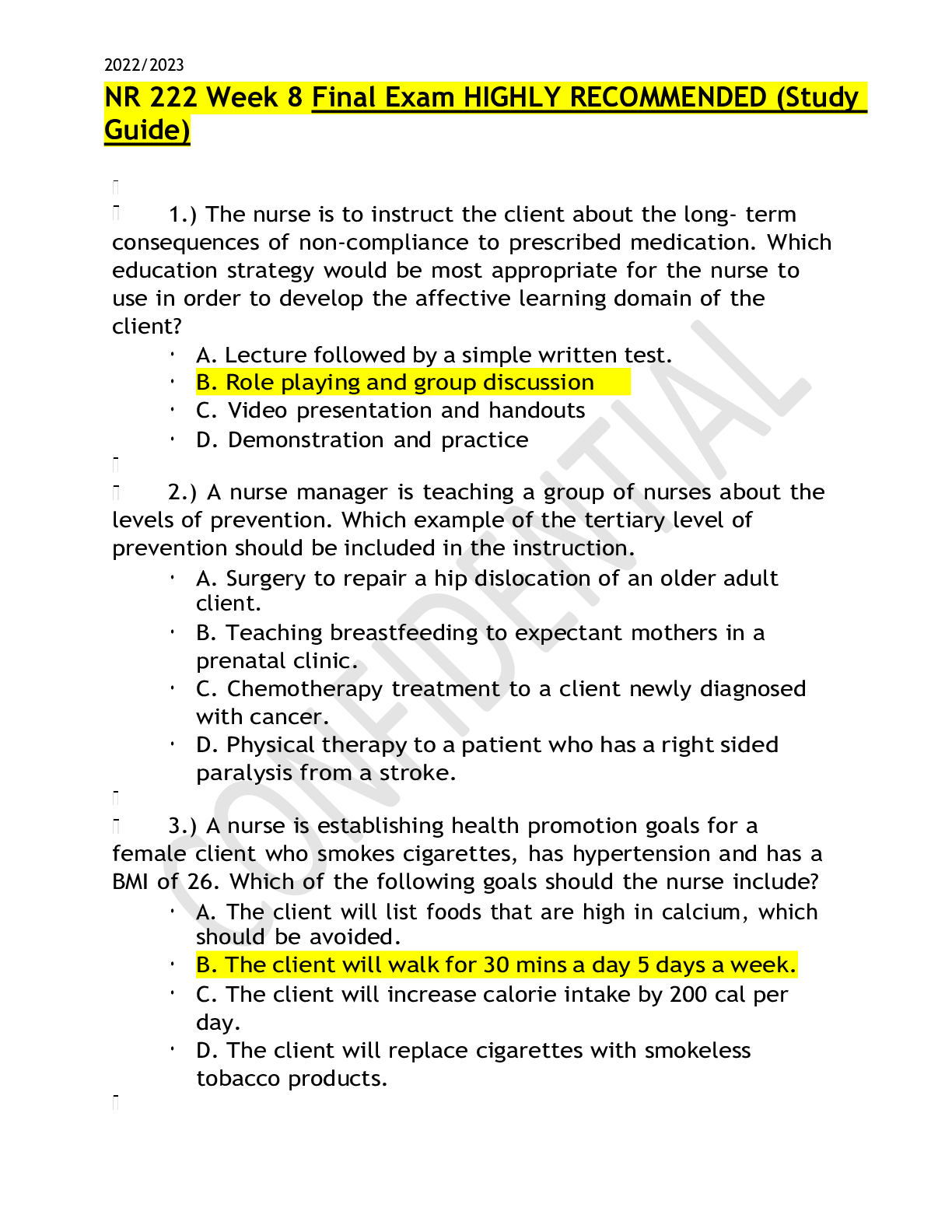


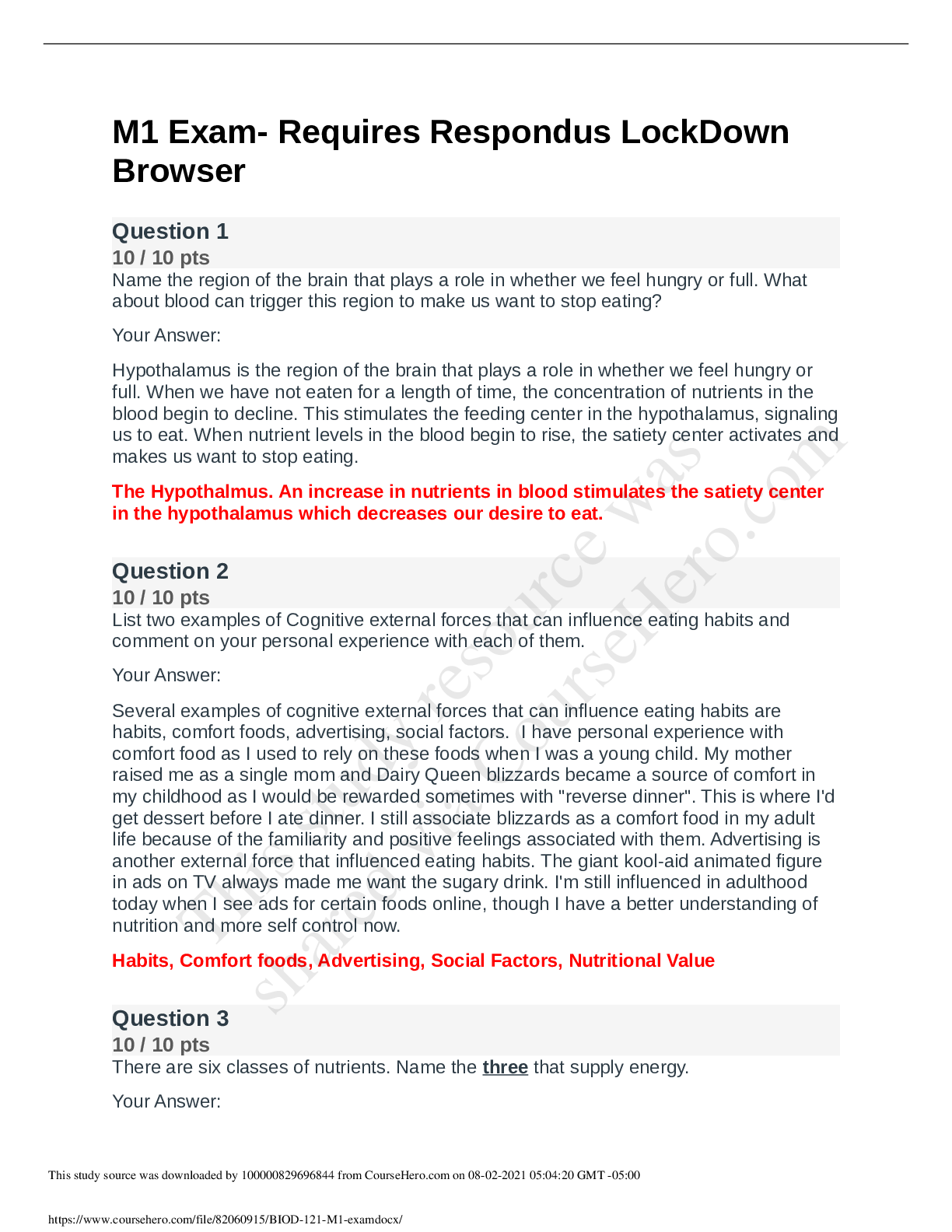
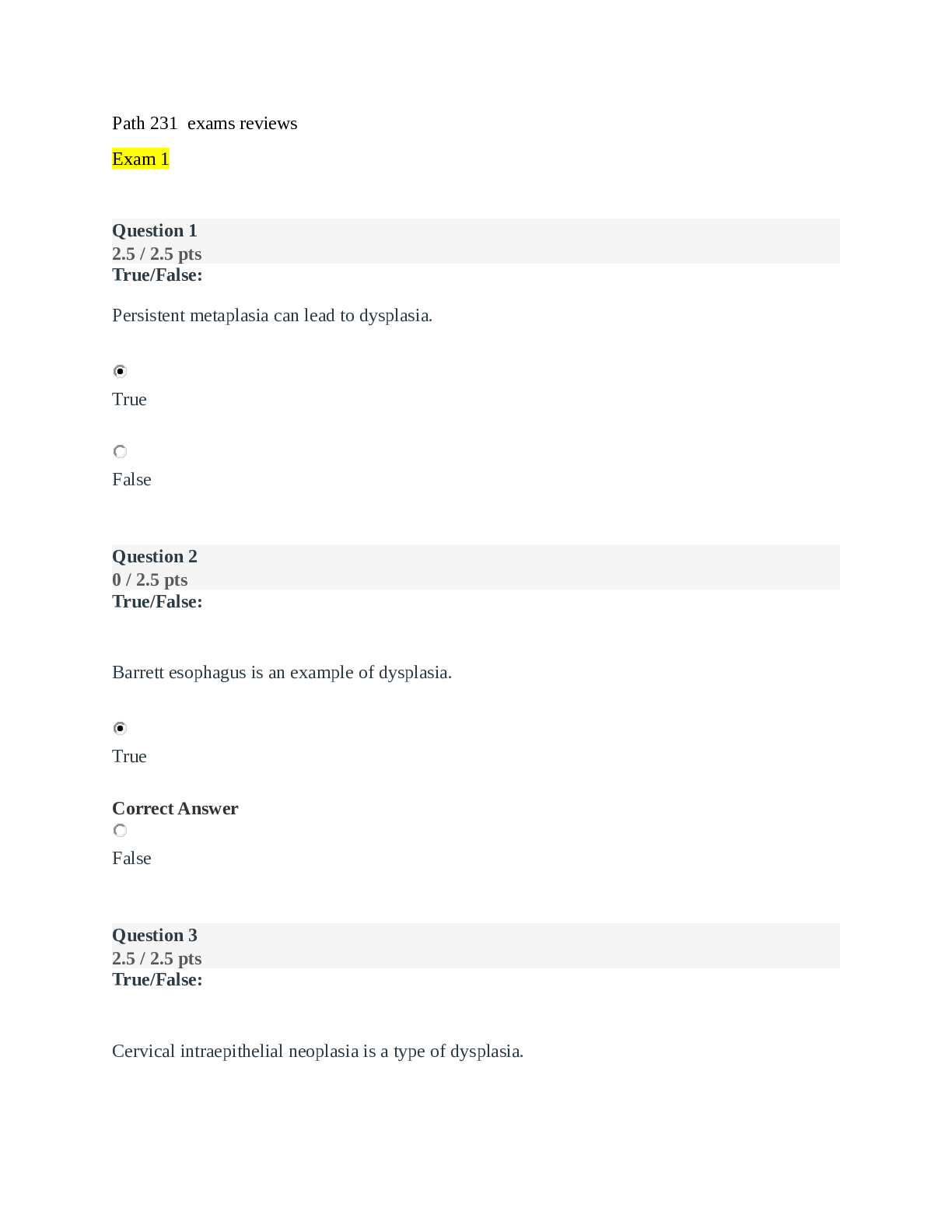

.png)



